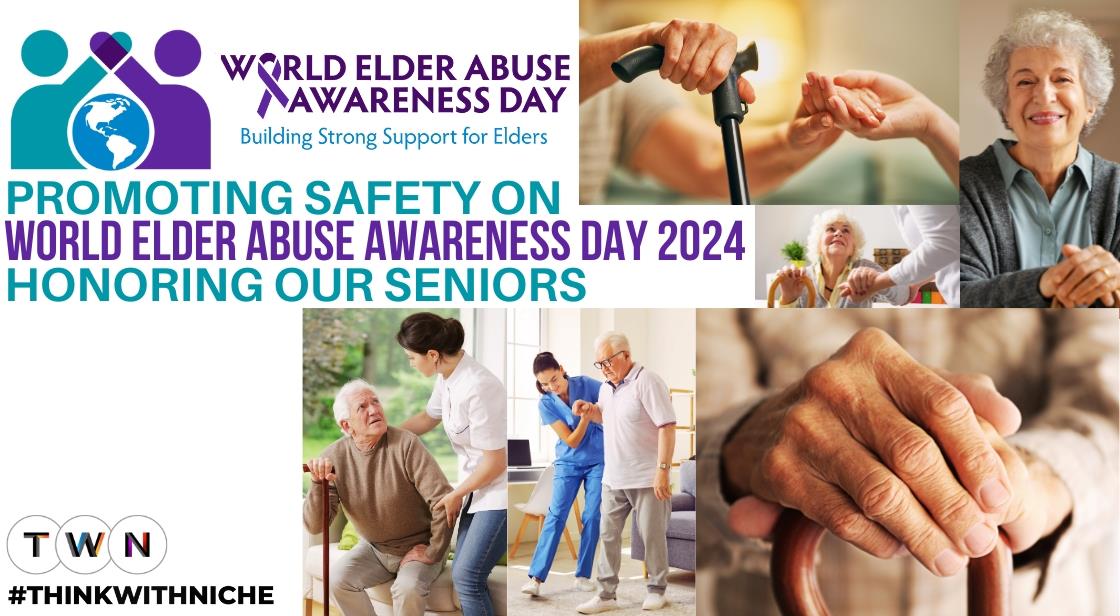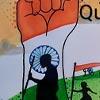Promoting Safety on World Elder Abuse Awareness Day 2024: Honoring Our Seniors

Blog Post
World Elder Abuse Awareness Day (WEAAD), observed annually on June 15th, is a crucial initiative aimed at highlighting the often overlooked issue of elder abuse. This day serves as a reminder of the importance of protecting and honoring our seniors, who deserve to live with dignity and respect.
Elder abuse, which can manifest in various forms such as physical, emotional, financial exploitation, and neglect, remains a pervasive and underreported problem globally.
According to the World Health Organization (WHO), approximately 1 in 6 individuals aged 60 and older experienced some form of abuse in the past year, a stark reality that underscores the need for increased vigilance and advocacy.
In the United States alone, the National Center on Elder Abuse (NCEA) reported that 15.7% of elder abuse cases involved physical harm, while emotional abuse accounted for a staggering 61.3% of cases. Financial exploitation is another significant concern, with a 2021 report by AARP estimating that older adults lose around $36 billion annually due to financial abuse.
In India, elder abuse remains a serious issue, with a 2014 HelpAge India report indicating that 4% of the elderly population faces mistreatment. The COVID-19 pandemic has further exacerbated the vulnerability of older adults, leading to increased isolation and dependence on caregivers.
As WEAAD 2024 approaches, it is imperative to recognize the signs of elder abuse, promote awareness, and support efforts to create a safer environment for our aging population.
By understanding the different types of abuse and their warning signs, we can better protect our elders and ensure they receive the care and respect they deserve.
This year's WEAAD campaign emphasizes the importance of community involvement, education, and preventive measures to combat elder abuse and honor our seniors.
Understanding World Elder Abuse Awareness Day 2024
World Elder Abuse Awareness Day (WEAAD), held annually on June 15th, is a critical day dedicated to raising awareness about the mistreatment of older adults. While the thought of someone intentionally harming an elder is unimaginable, elder abuse is a shockingly widespread problem. It can take various forms, from financial exploitation to physical neglect, and often goes unreported. WEAAD serves as a crucial reminder to be vigilant, informed, and take action to protect our most vulnerable populations.
Understanding Elder Abuse: A Deeper Look
Elder abuse is a pervasive and often hidden issue. It takes many forms, inflicting emotional, physical, and financial harm on our most vulnerable population. Here's a detailed breakdown of the different types of elder abuse, along with recent data, examples, and warning signs:
1. Elder Physical Abuse:
-
Definition: This involves inflicting physical harm on an elder, such as hitting, pushing, kicking, pinching, burning, or using restraints without a legitimate medical reason.
-
Facts and Figures: A 2020 study by the National Center on Elder Abuse (NCEA) in the US found that physical abuse was reported in 15.7% of elder abuse cases.
-
Examples of Elder Physical Abuse : Deliberately causing injuries during caregiving activities, withholding medical care, or forcing an elder to take medication they don't need.
-
Warning Signs: Unexplained bruises, cuts, burns, or bedsores; fractures; signs of inappropriate restraint, like rope marks or excessive use of sedatives.
2. Elder Emotional Abuse:
-
Definition: This involves verbal abuse, threats, intimidation, humiliation, isolation, or belittling an elder's dignity. It can also encompass gaslighting, where the abuser denies or minimizes the abuse or makes the elder question their own reality.
-
Facts and Figures: The NCEA study mentioned above also found that emotional abuse was reported in 61.3% of elder abuse cases, highlighting its prevalence.
-
Examples: Yelling, swearing, name-calling, making threats of violence, isolating an elder from loved ones, or constantly criticizing their appearance or abilities.
-
Warning Signs: Depression, anxiety, withdrawal, fearfulness, or changes in personality; sudden changes in an elder's relationship with a caregiver; an elder who seems hesitant to speak freely.
3. Elder Sexual Abuse:
-
Definition: This is any form of unwanted sexual contact or behavior, including forced sexual intercourse, groping, or sexual harassment.
-
Facts and Figures: Due to underreporting, the exact prevalence of sexual abuse among elders is difficult to determine. However, a 2018 study by the National Sexual Violence Resource Center found that 1 in 10 older adults in nursing homes experience some form of sexual assault.
-
Examples: Forcing an elder to engage in sexual activity, making lewd comments, or exposing them to unwanted sexual advances.
-
Warning Signs: Signs of physical injuries in the genital area, unexplained sexually transmitted infections (STIs), withdrawal from physical intimacy, or changes in an elder's sexual behavior.
4. Elder Financial Exploitation:
-
Definition: This involves manipulating or deceiving an elder to steal their money or assets. Examples include forging checks, misusing credit cards, pressuring them to change wills or beneficiaries, or isolating them from financial advisors.
-
Facts and Figures: A 2021 report by the AARP found that in the United States alone, older adults lose an estimated $36 billion annually due to financial exploitation.
-
Examples: A caregiver stealing an elder's money or using their credit cards without permission; pressuring them to invest in risky schemes; isolating them from trusted financial advisors.
-
Warning Signs: Missing money or valuables; unpaid bills; sudden changes in financial documents or wills; an elder appearing financially strained despite having a good income.
5. Neglect:
-
Definition: This is the failure to provide an elder with basic necessities like food, water, shelter, medication, hygiene assistance, or medical care.
-
Facts and Figures: According to the WHO, neglect is the most common form of elder abuse globally.
-
Examples: Leaving an elder alone for extended periods without access to food or water; failing to provide them with proper hygiene care or medication; allowing them to live in unsafe or unsanitary conditions.
-
Warning Signs: Dehydration, malnutrition, poor hygiene, bedsores, signs of infection, an unkempt living environment, or an elder expressing feelings of abandonment or neglect.
By recognizing the different forms of elder abuse and their warning signs, we can be better equipped to protect our vulnerable elders. Remember, even if you suspect abuse, it's crucial to report it to the appropriate authorities.
Also Read: Exploring the Top Apps for Anxiety Relief: Elevate Your Well-Being
World Elder Abuse Awareness Day Timeline
Here's a timeline highlighting key milestones in World Elder Abuse Awareness Day (WEAAD):
2006:
-
June 15th: WEAAD is launched by the International Network for the Prevention of Elder Abuse (INPEA) and the World Health Organization (WHO). This initial launch signifies the growing recognition of elder abuse as a global issue.
2011:
-
December: The United Nations General Assembly adopts resolution 66/127, officially designating June 15th as World Elder Abuse Awareness Day. This international recognition elevates the profile of WEAAD and encourages broader participation from governments and organizations worldwide.
Since 2011:
-
Annual Focus: Each year, WEAAD campaigns often focus on specific themes or aspects of elder abuse. These themes raise awareness about different forms of abuse, risk factors, or strategies for prevention and intervention.
-
Growing Advocacy: WEAAD has become a catalyst for increased advocacy efforts globally. Governments, NGOs, healthcare professionals, and community organizations utilize this day to organize awareness campaigns, educational workshops, and public outreach programs.
-
Focus on Data and Resources: Over the years, there's been a growing emphasis on collecting data on the prevalence of elder abuse and developing resources to support victims, families, and professionals.
-
Technological Advancements: As technology evolves, WEAAD campaigns increasingly leverage social media platforms to reach broader audiences and facilitate information sharing. Hashtags like #WEAAD and online resources offer avenues for public engagement and education.
Looking Ahead:
-
Continued Advocacy: Future WEAAD campaigns are likely to continue advocating for stronger legal frameworks, improved reporting systems, and enhanced support services for victims of elder abuse.
-
Focus on Prevention: There may be a growing focus on preventive measures, such as promoting financial literacy among older adults and educating caregivers about recognizing and responding to potential abuse.
-
Intergenerational Collaboration: WEAAD campaigns could increasingly encourage intergenerational collaboration to foster a more supportive environment for our aging population.
This timeline provides a snapshot of the evolution of World Elder Abuse Awareness Day. WEAAD continues to play a vital role in raising global awareness about elder abuse and promoting action to protect our most vulnerable populations.
Latest Facts About Elder Abuse: A Global and Indian Perspective
Elder abuse is a serious public health and human rights issue affecting millions globally. Here's a compilation of recent data and facts highlighting the scope of the problem, both internationally and in India:
Global Impact:
-
Prevalence: According to the World Health Organization (WHO), an estimated 1 in 6 people aged 60 years and older worldwide experienced some form of elder abuse in the past year. This translates to a staggering number of vulnerable individuals facing mistreatment.
-
Underreporting: A significant challenge is underreporting. The WHO estimates that only a fraction of elder abuse cases are ever reported, making it difficult to assess the true extent of the problem.
-
Financial Exploitation: A growing concern is financial exploitation. A 2021 report by the AARP found that in the United States alone, older adults lose an estimated $36 billion annually due to financial abuse.
-
Risk Factors: Social isolation, dependence on others for care, cognitive decline, and a history of domestic violence are some of the risk factors associated with elder abuse.
Elder Abuse in India:
-
Limited Data: While data on elder abuse in India is scarce compared to developed countries, available information suggests a concerning trend.
-
HelpAge India Report: A 2014 report by HelpAge India, an NGO working for elder rights, estimated that 4% of elderly people in India face abuse. This translates to millions of potentially vulnerable individuals.
-
Types of Abuse: Similar to global trends, elder abuse in India can take various forms, including physical abuse, emotional abuse, financial exploitation, neglect, and abandonment.
-
Social Stigma and Silence: Cultural norms and social stigma often prevent victims from speaking up, further hindering efforts to address the issue.
Additional Facts about Elder abuse:
-
Increased Vulnerability During Pandemics: The COVID-19 pandemic exacerbated elder abuse due to social isolation, increased dependence on caregivers, and potential economic hardship.
-
Impact on Mental and Physical Health: Elder abuse can have severe consequences for victims' mental and physical health, leading to depression, anxiety, and even premature mortality.
-
Importance of Awareness and Prevention: Raising awareness, educating communities, and promoting open communication are crucial steps towards preventing elder abuse and ensuring the well-being of our aging population.
Looking Ahead:
-
Strengthening Legal Frameworks: Advocacy efforts are needed to strengthen legal frameworks that protect elders and facilitate reporting of abuse.
-
Support Services and Resources: Developing accessible and comprehensive support services for victims, families, and professionals is essential.
-
Empowering Older Adults: Promoting financial literacy, fostering social connections, and advocating for elder rights can empower older adults and reduce their vulnerability to abuse.
By understanding the global and Indian context of elder abuse, we can work towards creating a more supportive and protective environment for our elders.
Warning Signs of Elder Abuse: Be a Beacon of Protection
Elder abuse is a hidden epidemic, often shrouded in silence and shame. Recognizing the signs is crucial for intervention and protecting our vulnerable elders. Here's a detailed breakdown of key red flags, along with recent data and examples, to help you identify potential abuse:
Physical Injuries:
-
Look for: Unexplained bruises, cuts, burns, fractures, sprains, or bedsores. These could be indicators of physical abuse, like hitting, pushing, or improper restraint.
-
Data Point: A 2020 study by the National Center on Elder Abuse (NCEA) found physical abuse reported in 15.7% of elder abuse cases, highlighting its prevalence.
-
Example: An elder with unexplained bruises on their arms or legs, especially if they coincide with changes in caregiver behavior.
Changes in Behavior and Demeanor:
-
Observe for: Depression, anxiety, withdrawal, listlessness, fearfulness, or sudden changes in personality. These could be signs of emotional abuse, such as verbal assaults, humiliation, or intimidation.
-
Data Point: The NCEA study also found 61.3% of elder abuse cases involved emotional abuse, underlining its frequency.
-
Example: An elder who used to be social and outgoing becomes withdrawn and reluctant to speak up, particularly around a specific caregiver.
Financial Discrepancies:
-
Be aware of: Missing money or valuables, unpaid bills, unexpected changes in wills or beneficiaries, unauthorized use of credit cards, or pressure to invest in risky schemes. These could indicate financial exploitation.
-
Fact: A 2021 AARP report estimates that older adults in the US lose $36 billion annually to financial abuse.
-
Example: An elder with a history of managing finances well suddenly seems confused about their accounts, or there are unexplained withdrawals from their bank statements.
Unsanitary Living Conditions and Neglect:
-
Check for: Unsanitary living spaces, lack of access to food or medication, inadequate hygiene assistance, or unsafe living conditions with hazards like loose rugs or poor lighting. These could be signs of neglect.
-
Global Concern: According to the WHO, neglect is the most common form of elder abuse worldwide.
-
Example: An elder living in a cluttered and dirty environment, with empty cupboards and no access to fresh food or medication.
Fear and Hesitation to Speak Up:
-
Notice if: An elder seems hesitant to discuss their living situation or caregivers, avoids eye contact, or appears afraid to speak freely. This could be a sign of intimidation or abuse.
-
Breaking the Silence: Many elders feel ashamed or afraid to report abuse.
Remember: Even if you suspect abuse, it's crucial to report it to the appropriate authorities. Here are some resources that can help:
By being observant and aware of these warning signs, you can become a beacon of protection for our most vulnerable population. If you see something, say something. Your voice can make a significant difference in an elder's life.
Taking Action and Spreading Awareness
If you suspect elder abuse, here are some steps you can take:
-
Document the abuse: Take pictures of injuries, keep records of suspicious behavior, and note any changes in the elder's well-being.
-
Report the abuse: Contact adult protective services, law enforcement, or a trusted healthcare professional.
-
Advocate for the elder: Communicate your concerns and offer support to the elder involved.
Top Apps and Support Organizations for Elders:Keeping Your Loved Ones Safe:
As our loved ones age, ensuring their safety and well-being becomes a top priority. Technology and dedicated organizations can be powerful allies in this endeavor. Here's a look at some of the best apps and support organizations that can empower both elders and their caregivers:
Empowering Apps for Elders:
-
Medication Management: Apps like Medisafe and MyMeds offer reminders, track prescriptions, and even send medication reports to healthcare providers, ensuring timely medication adherence.
-
Safety and Communication: Senior Safety App and Life360 provide real-time location sharing, emergency assistance buttons, and allow for check-ins, promoting safety and peace of mind for both elders and caregivers.
-
Organization and Care Coordination: Apps like Lotsa Helping Hands and CaringBridge help families create shared calendars, manage care schedules, and keep everyone informed, streamlining care and communication.
Supportive Organizations for Elders:
-
National Institute on Aging (NIA): Provides a wealth of information on elder care topics, resources to locate local support services, and connects individuals with research opportunities.
-
Eldercare Locator (AARP): A user-friendly tool to find local elder care services, including in-home care, transportation, legal assistance, and more.
-
National Adult Protective Services Association (NAPSA): Advocates for the protection of vulnerable adults and helps connect victims of abuse with essential resources.
-
Family Caregiver Alliance: Offers support, education, and resources for caregivers, empowering them to navigate the challenges of elder care.
Remember: These are just a few examples, and the best options will depend on your specific needs and preferences. Researching and exploring available resources is key to finding the perfect fit for your loved ones.
Spreading Awareness: World Elder Abuse Awareness Day provides a valuable platform to raise awareness and educate communities about elder abuse. Here are some ways to participate:
-
Share information on social media: Use the hashtag #WEAAD and share educational resources about elder abuse.
-
Organize a community event: Host a workshop or awareness program to educate others about the issue.
-
Talk to friends and family: Discuss the importance of recognizing and reporting elder abuse.
-
Support organizations working with elders: Volunteer your time or donate to organizations that advocate for and protect older adults.
Conclusion
World Elder Abuse Awareness Day serves as a powerful reminder that protecting our elders is a shared responsibility. By recognizing the signs of abuse, taking action, and spreading awareness, we can create a safer and more supportive environment for our aging population. Remember, even a small act can make a significant difference in the life of a vulnerable elder. Let's work together to ensure that our seniors are treated with dignity and respect.
You May Like
EDITOR’S CHOICE












